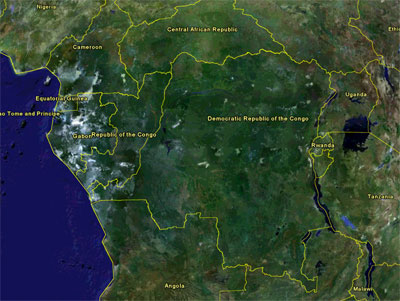CAMEROON
Please note, this page is not longer being updated. For more recent information, please see news.mongabay.com and use the search function to find the country feed. For more up-to-date data on forest cover and loss, check out Global Forest Watch.
| Cameroon Forest Figures
Forest Cover Total forest area: 21,245,000 ha % of land area: 45.6% Primary forest cover: n/a % of land area: n/a % total forest area: n/a Deforestation Rates, 2000-2005 Annual change in forest cover: -220,000 ha Annual deforestation rate: -1.0% Change in defor. rate since '90s: 9.8% Total forest loss since 1990: -3,300,000 ha Total forest loss since 1990:-13.4% Primary or "Old-growth" forests Annual loss of primary forests: n/a Annual deforestation rate: n/a Change in deforestation rate since '90s: n/a Primary forest loss since 1990: n/a Primary forest loss since 1990:n/a Forest Classification Public: 100% Private: 0% Other: 0% Use Production: 29.3% Protection: 2.7% Conservation: 48.6% Social services: 1% Multiple purpose: 18.4% None or unknown: n/a Forest Area Breakdown Total area: 21,245,000 ha Primary: n/a Modified natural: n/a Semi-natural: n/a Production plantation: n/a Production plantation: n/a Plantations Plantations, 2005: n/a % of total forest cover: n/a Annual change rate (00-05): n/a Carbon storage Above-ground biomass: 2,679 M t Below-ground biomass: 1,125 M t Area annually affected by Fire: n/a Insects: n/a Diseases: n/a Number of tree species in IUCN red list Number of native tree species: 600 Critically endangered: 50 Endangered: 27 Vulnerable: 106 Wood removal 2005 Industrial roundwood: 3,211,000 m3 o.b. Wood fuel: 16,561,000 m3 o.b. Value of forest products, 2005 Industrial roundwood: n/a Wood fuel: n/a Non-wood forest products (NWFPs): n/a Total Value: n/a More forest statistics for Cameroon |
In the recovery following the economic crisis caused by the devaluation of the CFA Franc, building and public works projects increased domestic demand for timber products. In 1999 Cameroon banned the export of some endangered hardwoods, though not sapelli and ayous, the country's largest hardwood exports. The move came after several years of heavy logging and the country's failure to successfully implement a policy aimed at reducing raw-log exports and encouraging processed wood exports.
Lacking an effective forest conservation program and suffering from endemic and pervasive corruption—it annually ranks near the top of the list for the world's most corrupt countries—Cameroon has found logging highly damaging to the rainforest environment. According to published reports, foreign loggers—the vast majority of logging companies operating in Cameroon are foreign-owned—have aggressively and unsustainably logged their concessions without much concern over prosecution by corrupt forestry officials.
The trafficking of bushmeat thrives in Cameroon in conjunction with the timber industry. Logging workers supplement their incomes by hunting wildlife and sending meat to urban centers.
Besides logging, deforestation results from fuelwood collection and subsistence farming. Overall, Cameroon lost 13.4 percent of its forest cover or 3.3 million hectares between 1990 and 2005 and deforestation rates have increased by 10 percent since the close of the 1990s. The United Nations doesn't classify any of Cameroon's forest cover as untouched primary forest.
Deforestation is beginning to have a significant environmental impact in parts of the country. In the north, deforestation has been blamed for increasing soil erosion, desertification, and reduced quality of pastureland. Overhunting and overfishing is a problem elsewhere in Cameroon.
Cameroon's moderately repressive government has made life difficult for the country's Indigenous forest dwellers, the pygmies. The government refuses to recognize their land rights and prohibits them from living in national parks.
Petroleum is a key export for Cameroon. To date, oil production has had a limited impact on the country's environment. In 2003 a $3.7-billion pipeline running through Cameroon from oil fields in Chad was completed. Its construction resulted in forest clearing and raised environmental concerns. The project was sponsored and owned by Exxon/Mobil (40 percent), Petronas Malaysia (35 percent), and Chevron (25 percent).
Cameroon has the second-largest hydroelectric power potential in Africa after the Congo. There is increasing concern among environmental groups that the country will start to build dams to meet growing energy needs—the country is not energy self-sufficient as of 2006. One currently planned project is the Lom river hydroelectric dam. To pay for the project, the government will borrow $120 million from the World Bank.
Cameroon currently lacks an effective protected-areas system. Eight percent of the country is under some form of protection on paper, but enforcement is weak and timber is illegally harvested from reserves and wildlife is poached. Conserving Cameroon's forests should be a top priority given their high level of biodiversity. The country has some 936 species of birds, 211 mammals, 322 reptiles, 192 amphibians, and 8,260 species of plants. Some of the better known protected areas in Cameroon are Campo Ma�an National Park, Dja Reserve, Lobek� National Park, Waza National Park, and Korup National Park. All have suffered from illegal incursions in recent years.
Recent articles | Cameroon news updates | XML
Suggested reading/Books on Cameroon
- >Forests Monitor Profile: Cameroon
- The Bradt Travel Guide to Cameroon
- Culture and Customs of Cameroon
- Bushdoctor in Cameroon
- Last Place on Earth
Unless otherwise specified, this article was written by Rhett A. Butler [Bibliographic citation for this page]
Other resources
Contact me if you have suggestions on other rainforest-related environmental sites and resources for this country.

Image copyright Google Earth, MDA EarthSet, DigitalGlobe 2005
CIA-World Factbook Profile
FAO-Forestry Profile
World Resources Institute
Last updated: 4 Feb 2006
